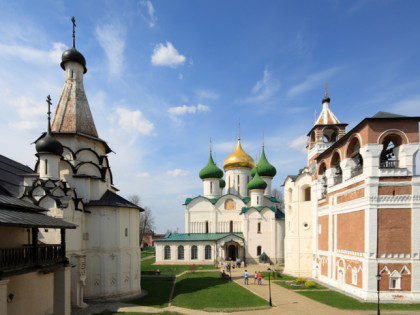Spaso–Evfimievsky Monastery: Museums instead of Cells
Spaso-Evfimievsky Monastery traces its history in Suzdal back to the 16th century, when the first stone church was erected on its territory over the grave of Saint Evfimiy of Suzdal. Now it is the Evfimievsky side-chapel of the white-stone Spaso-Preobrazhensky Cathedral of the 16th century. The walls of the five-domed church were painted by the outstanding master Gury Nikitin. However, these frescos were opened and restored only in the 1970s. At the moment there are several curious expositions on the territory of the monastery.
To the east of the Spaso-Preobrazhensky Cathedral, there is a chapel monument on the tomb of Prince Dmitry Pozharsky, who liberated Moscow in the Time of Troubles in the 17th century together with Kuzma Minin. The Church of the Annunciation houses an exhibition in dedicated to the life of the prince. Here you can also see the precious donations of the Pozharsky princes: the carved imperial gates and the ceremonial chasuble. The oldest buildings of the Spaso-Evfimievsky Monastery include the belfry of the 16th century. The ringing of its 17 bells can be heard five times a day. The territory of the monastery also houses a Church of the Assumption of the 16th century, where the first Museum of the Naive Art in Russia was opened in 2006. The Archimandrite House is worth a visit to see the collection of icons of the XVIII - XX centuries, among which there is a copy of the famous "Trinity" by the ancient icon painter Andrei Rublev. The original icon was transferred to the Russian Museum in St. Petersburg in 1913. The Bratsky House offers a unique opportunity to watch the work of restorers. The details of the monks’ prerevolutionary life are reproduced here in the cells. The Nikolskaya Hospital Church houses an exposition "The Gold Depository" with Byzantine crosses of the XIV century, gold embroidery, bowls and thuribles gifted by tsars, as well as icon frames.































